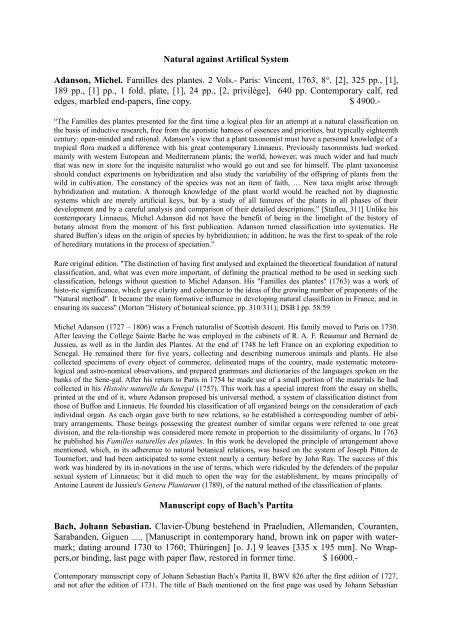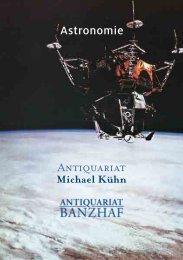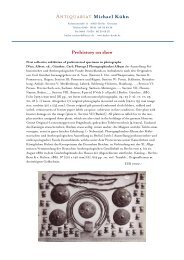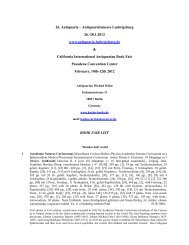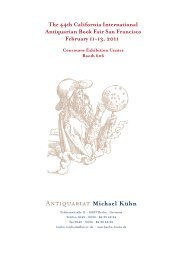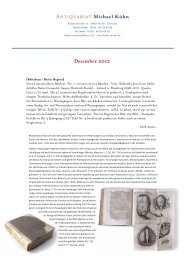List New York Antiquarian Book Fair - Antiquariat - Michael Kühn
List New York Antiquarian Book Fair - Antiquariat - Michael Kühn
List New York Antiquarian Book Fair - Antiquariat - Michael Kühn
Create successful ePaper yourself
Turn your PDF publications into a flip-book with our unique Google optimized e-Paper software.
Natural against Artifical System<br />
Adanson, Michel. Familles des plantes. 2 Vols.- Paris: Vincent, 1763, 8°. [2], 325 pp., [1],<br />
189 pp., [1] pp., 1 fold. plate, [1], 24 pp., [2, privilège], 640 pp. Contemporary calf, red<br />
edges, marbled end-papers, fine copy. $ 4900.-<br />
“The Familles des plantes presented for the first time a logical plea for an attempt at a natural classification on<br />
the basis of inductive research, free from the aporistic harness of essences and priorities, but typically eighteenth<br />
century: open-minded and rational. Adanson’s view that a plant taxonomist must have a personal knowledge of a<br />
tropical flora marked a difference with his great contemporary Linnaeus. Previously taxonomists had worked<br />
mainly with western European and Mediterranean plants; the world, however, was much wider and had much<br />
that was new in store for the inquisite naturalist who would go out and see for himself. The plant taxonomist<br />
should conduct experiments on hybridization and also study the variability of the offspring of plants from the<br />
wild in cultivation. The constancy of the species was not an item of faith, … <strong>New</strong> taxa might arise through<br />
hybridization and mutation. A thorough knowledge of the plant world would be reached not by diagnostic<br />
systems which are merely artificial keys, but by a study of all features of the plants in all phases of their<br />
development and by a careful analysis and comparison of their detailed descriptions.” [Stafleu, 311] Unlike his<br />
contemporary Linnaeus, Michel Adanson did not have the benefit of being in the limelight of the history of<br />
botany almost from the moment of his first publication. Adanson turned classification into systematics. He<br />
shared Buffon’s ideas on the origin of species by hybridization; in addition, he was the first to speak of the role<br />
of hereditary mutations in the process of speciation.”<br />
Rare original edition. "The distinction of having first analysed and explained the theoretical foundation of natural<br />
classification, and, what was even more important, of defining the practical method to be used in seeking such<br />
classification, belongs without question to Michel Adanson. His "Familles des plantes" (1763) was a work of<br />
histo-ric significance, which gave clarity and coherence to the ideas of the growing number of proponents of the<br />
"Natural method". It became the main formative influence in developing natural classification in France, and in<br />
ensuring its success" (Morton "History of botanical science, pp. 310/311); DSB I pp. 58/59<br />
Michel Adanson (1727 – 1806) was a French naturalist of Scottish descent. His family moved to Paris on 1730.<br />
After leaving the College Sainte Barbe he was employed in the cabinets of R. A. F. Reaumur and Bernard de<br />
Jussieu, as well as in the Jardin des Plantes. At the end of 1748 he left France on an exploring expedition to<br />
Senegal. He remained there for five years, collecting and describing numerous animals and plants. He also<br />
collected specimens of every object of commerce, delineated maps of the country, made systematic meteorological<br />
and astro-nomical observations, and prepared grammars and dictionaries of the languages spoken on the<br />
banks of the Sene-gal. After his return to Paris in 1754 he made use of a small portion of the materials he had<br />
collected in his Histoire naturelle du Senegal (1757). This work has a special interest from the essay on shells,<br />
printed at the end of it, where Adanson proposed his universal method, a system of classification distinct from<br />
those of Buffon and Linnaeus. He founded his classification of all organized beings on the consideration of each<br />
individual organ. As each organ gave birth to new relations, so he established a corresponding number of arbitrary<br />
arrangements. Those beings possessing the greatest number of similar organs were referred to one great<br />
division, and the rela-tionship was considered more remote in proportion to the dissimilarity of organs. In 1763<br />
he published his Familles naturelles des plantes. In this work he developed the principle of arrangement above<br />
mentioned, which, in its adherence to natural botanical relations, was based on the system of Joseph Pitton de<br />
Tournefort, and had been anticipated to some extent nearly a century before by John Ray. The success of this<br />
work was hindered by its in-novations in the use of terms, which were ridiculed by the defenders of the popular<br />
sexual system of Linnaeus; but it did much to open the way for the establishment, by means principally of<br />
Antoine Laurent de Jussieu's Genera Plantarum (1789), of the natural method of the classification of plants.<br />
Manuscript copy of Bach’s Partita<br />
Bach, Johann Sebastian. Clavier-Übung bestehend in Praeludien, Allemanden, Couranten,<br />
Sarabanden, Giguen …. [Manuscript in contemporary hand, brown ink on paper with watermark;<br />
dating around 1730 to 1760; Thüringen] [o. J.] 9 leaves [335 x 195 mm]. No Wrappers,or<br />
binding, last page with paper flaw, restored in former time. $ 16000.-<br />
Contemporary manuscript copy of Johann Sebastian Bach’s Partita II, BWV 826 after the first edition of 1727,<br />
and not after the edition of 1731. The title of Bach mentioned on the first page was used by Johann Sebastian


